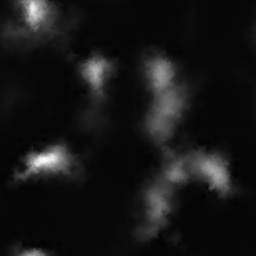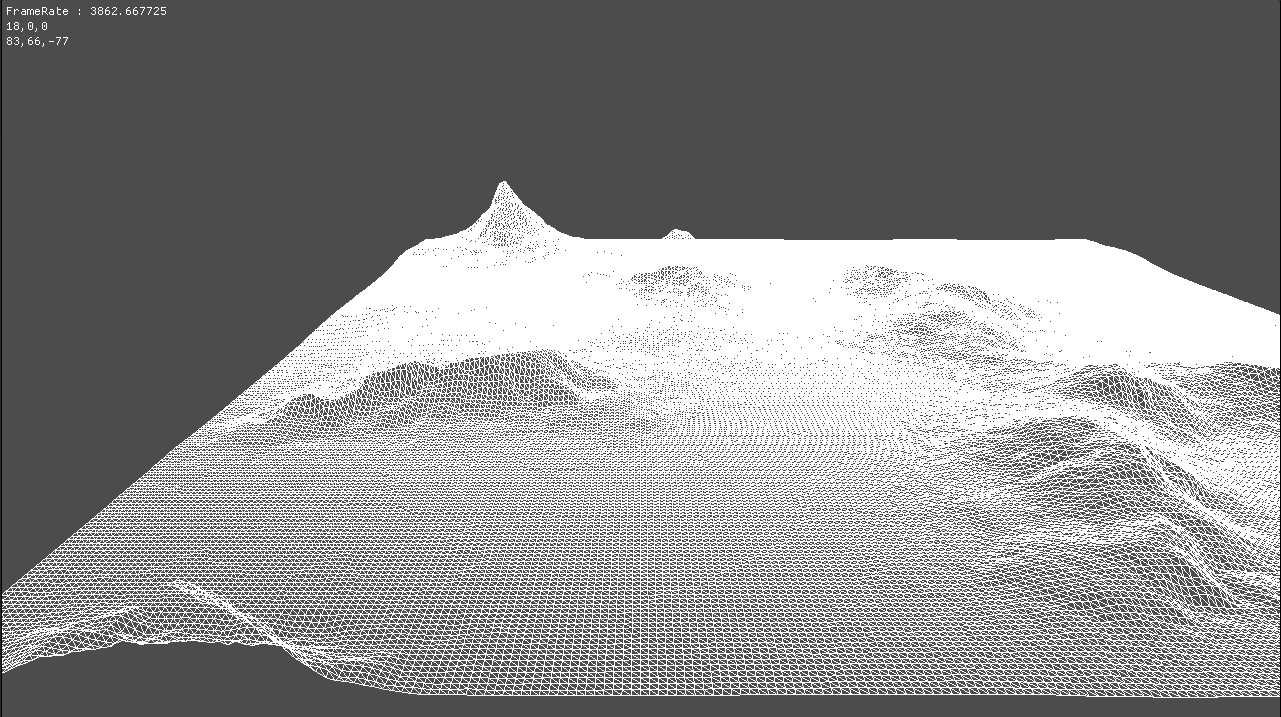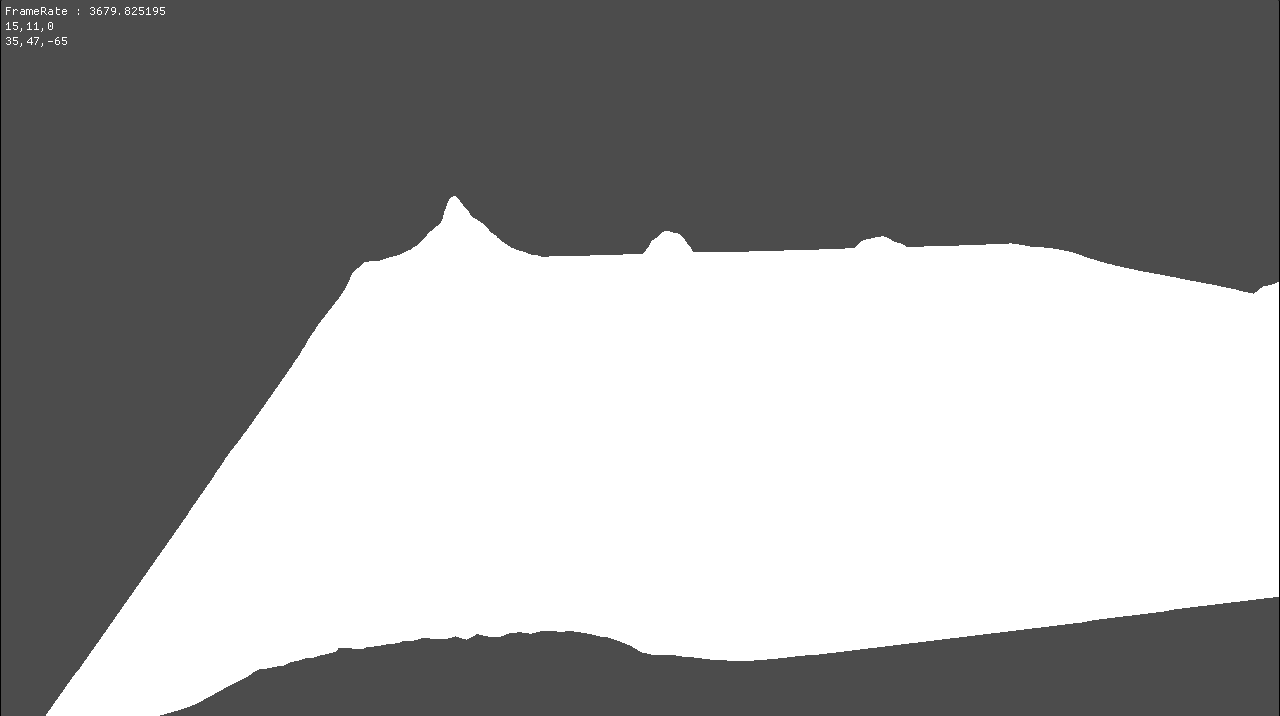HeightMap
지형에서 사용되는 높낮이를 표현하는 Map이다.
일반적으로

이런 텍스쳐를 갖고 작동하는데 처음엔 이게 뭔 높낮이 인가 싶다.
작동하는 방법은 하얀색으로 갈수록 높이 그려준다.
Terrian.h
#pragma once
class Terrain
{
public:
typedef Vertex TerrainVertex;
public:
Terrain(Shader* shader, wstring heightFile);
~Terrain();
void Update();
void Render();
void Pass(UINT val) { pass = val; }
private:
void CreateVertexData();
void CreateIndexData();
void CreateBuffer();
private:
UINT pass = 1;
Shader* shader;
Texture* heightMap;
UINT width;
UINT height;
UINT vertexCount;
TerrainVertex* vertices;
ID3D11Buffer* vertexBuffer;
UINT indexCount;
UINT* indices;
ID3D11Buffer* indexBuffer;
};
지형을 만들 헤더다 Framework에 만들었다.
방법은 삼각형 2개로 사각형을 만들고, 그것들을 많이 만들어 넓게 만드는 것이다.
Terrian.cpp
Terrain::Terrain(Shader * shader, wstring heightFile)
: shader(shader)
{
heightMap = new Texture(heightFile);
CreateVertexData();
CreateIndexData();
CreateBuffer();
}
생성자에선 텍스쳐 파일을 받아오고 Vertex, Index, Buffer를 만들어준다.
void Terrain::CreateVertexData()
{
vector<Color> heights;
heightMap->ReadPixel(DXGI_FORMAT_R8G8B8A8_UNORM, &heights);
width = heightMap->GetWidth();
height = heightMap->GetHeight();
vertexCount = width * height;
vertices = new TerrainVertex[vertexCount];
for (UINT z = 0; z < height; z++)
{
for (UINT x = 0; x < width; x++)
{
UINT index = width * z + x;
vertices[index].Position.x = (float)x;
vertices[index].Position.y = heights[index].r * 255.0f / 10.0f;
vertices[index].Position.z = (float)z;
}
}
}
텍스쳐의 가로 세로를 받아오고 그 넓이만큼 VertexCount를 세팅해준다.
그리고 Vertex를 VectexCount만큼 만들어준다.
그리고 그 만큼 만들어 준다. 높이는 현재 rgb중 r만큼 높게 만들어 준다.
void Terrain::CreateIndexData()
{
indexCount = (width - 1) * (height - 1) * 6;
indices = new UINT[indexCount];
UINT index = 0;
for (UINT y = 0; y < height - 1; y++)
{
for (UINT x = 0; x < width - 1; x++)
{
indices[index + 0] = width * y + x;
indices[index + 1] = width * (y + 1) + x;
indices[index + 2] = width * y + (x + 1);
indices[index + 3] = width * y + (x + 1);
indices[index + 4] = width * (y + 1) + x;
indices[index + 5] = width * (y + 1) + (x + 1);
index += 6;
}
}
}
Index도 사각형 찍듯이 만들어 준다.
쉐이더 경우에는 일반적으로 면을 생성하는 쉐이더에 PixelShader부분의 색을 원하는 색(지금은 흰색)으로 반환해준다.
HeightMapDemp.cpp
#include "stdafx.h"
#include "HeightMapDemo.h"
void HeightMapDemo::Initialize()
{
Context::Get()->GetCamera()->RotationDegree(12, 0, 0);
Context::Get()->GetCamera()->Position(35, 10, -55);
shader = new Shader(L"19_Terrain.fx");
terrain = new Terrain(shader, L"Terrain/Gray256.png");
terrain->Pass(1);
}
void HeightMapDemo::Destroy()
{
SafeDelete(shader);
SafeDelete(terrain);
}
void HeightMapDemo::Update()
{
terrain->Update();
}
void HeightMapDemo::Render()
{
terrain->Render();
}
그리고 실행을 해주면
Map

Texture
잘 보면 하얀색부분이 높게 솟아있다. 그런데 뭔가 이상하다 위 아래가 반대다.
왜냐하면 UV좌표계와 지금 DirectX의 좌표계가 다르기 때문이다.
그래서
UINT pixel = width * (height - 1 - z) + x;
vertices[index].Position.x = (float)x;
vertices[index].Position.y = heights[pixel].r * 255.0f / 10.0f;
vertices[index].Position.z = (float)z;
Vertex를 찍는 부분을 이렇게 바꾸면
잘 나온다.
하지만, wireframe을 색으로만 바꾸면,
와… 그냥 하얀색이다. 왜냐하면 아직 그림자가 없기 때문이다.
이걸 조금만 활용하면, height의 rgb값을 활용해서 높낮이나 다른 텍스쳐를 편하게 활용할 수 있을것 같다. 예를들어 빨간부분은 높이를 낮게 하고, 초록 부분은 물 텍스쳐를 입히고 파랑 부분은 검은색으로 없애던가 할 수 있을 것 같다.


